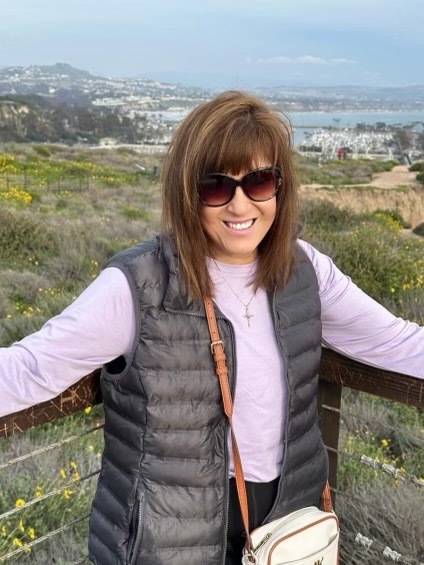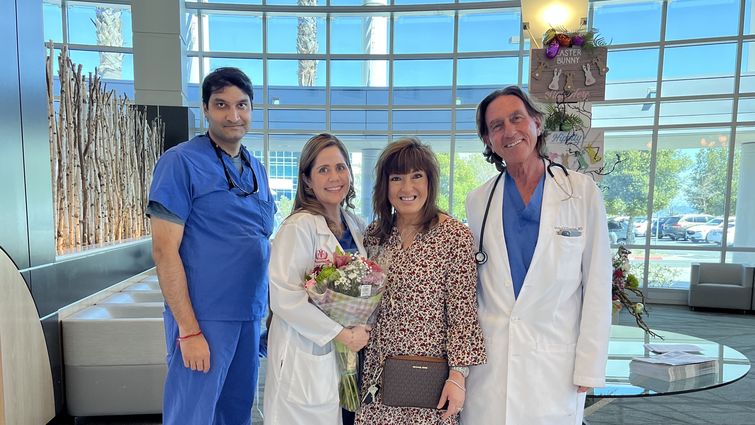

Melissa Peffer reunited with her care team members (from left: Dr. Niraj Parekh, nurse practitioner Karen Forhane, Melissa Peffer, Dr. Michael Koumjian) four months after her double bypass procedure at LLUMC–Murrieta.
59-year-old Melissa Peffer says she and her family had stared in shock at the five-centimeter-long piece of plaque Loma Linda University Medical Center – Murrieta’s (LLUMC–Murrieta) heart care team cleared from her largest coronary artery in January. Peffer has since rejoiced in a refreshed outlook on life and celebrated her restored health, finally free from the painful symptoms and extreme worry she’d endured for nearly a decade leading up to a life-saving procedure.
Peffer was checking receipts at her customer service job in Las Vegas in 2015 when an achy, throbbing pain she’d never felt before seized her chest and radiated down her left arm. Reporting these symptoms to her doctor, Peffer received a referral to a cardiologist who performed imaging of her heart and surrounding vasculature. The imaging revealed that her left anterior descending (LAD) artery was 100% blocked with plaque buildup. The cardiologist said the blockage was inoperable and incurable, and Peffer began to take heart medications.

Melissa Peffer found resolve at LLUMC–Murrieta after years of uncertainty and rejection.
Without proper remedy, a wholly blocked LAD artery can deprive the heart of vital blood supply and lead to what’s called a “widowmaker heart attack” — one of the deadliest kinds, says Niraj V. Parekh, MD, interventional cardiologist and medical director of LLUMC – Murrieta's Heart & Vascular Center. Over time, he says, the lack of blood supply can weaken the heart muscle and heighten the heart's risk of heart failure, arrhythmias, and aneurysms.
“Symptoms are a cry for help from the heart,” Parekh says, “and there can be long-term consequences if the heart is unhappy.”
Despite medications, Peffer's shortness of breath and chest pains persisted as time wore on. She sought consultations with cardiologists from major academic and tertiary care centers nationwide in hopes of undergoing a procedure to remove the blockage. Each time, they turned her down.
I was facing a complete death sentence and a silent killer heart attack, like a ticking time bomb waiting to take my life.Melissa Peffer
Parekh says the specialists who turned Peffer down may have done so because of Peffer’s unique anatomy and small vessels, the precarious placement of the blockage, and the health risks of performing a procedure via minimally invasive intervention or open surgery without a likelihood of guaranteed success.
Her search for proper care stretched on for eight years, Peffer says. She quit her job, limited her physical activity, and tried to manage her stress levels; she says she was terrified of “awakening” the heart attack that could take her life. However, she says her family and faith helped boost her will to keep pushing.
"I was facing a complete death sentence and a silent killer heart attack, like a ticking time bomb waiting to take my life," Peffer says. “The weight, mentally, emotionally, and physically, is so catastrophic that you can’t even swallow it.”
It wasn’t until she and her husband moved from Las Vegas to Southern California that Peffer met with Parekh at LLUMC–Murrieta — and reluctantly so, she says, for fear of facing another rejection. Yet, to Peffer's surprise and immense relief, the heart care team at LLUMC–Murrieta told her there was a solution.
Parekh had run meticulous imaging tests of Peffer’s heart and surrounding anatomy, creating a clear roadmap of blockages and vasculature. Cardiothoracic surgeon Michael Koumjian, MD, then analyzed the imaged roadmap and determined a way forward for Peffer’s case.
I see everything brand new and want to be able to share with other people that nothing is hopeless.Melissa Peffer
The team had to get creative in strategizing how to approach Peffer’s unique procedure, Parekh says. Koumjian first completed an endarterectomy to clean out plaque in Peffer’s arteries, including the five-centimeter blockage in her LAD. It is unusual to perform endarterectomies in coronary arteries because of their smaller size, Parekh says, but Koumjian needed to clear out the plaque to make room for a double bypass.
Cardiothoracic surgeon Michael Koumjian removed a five-centimeter long plaque that had been blocking Melissa Peffer's LAD artery.
During the double bypass, Koumjian sutured arteries from other parts of the body — including the chest wall or legs — to the coronary arteries and the aorta to create alternate routes that bypass blockage sites for blood and oxygen to reach Peffer’s heart.
“I still can’t even believe I’m actually here,” says Peffer, now five months after her procedure. “I see everything brand new and want to be able to share with other people that nothing is hopeless.”
Now, she says she feels called to spread the word about the unique procedure and LLUMC–Murrieta cardiologists who saved her life, spreading awareness to other physicians and patients struggling with similar health issues.
Peffer says her health journey has brought her even closer to God and her family — her husband, two children, and two grandchildren. She says she feels more comfortable being active and has recently returned from travels in Italy and France with her husband.
“Our collaborative, multidisciplinary cardiac team combines ingenuity and creativity with skill and experience to create life-changing solutions every day for patients like Mrs. Peffer,” Parekh says. “We are always willing to go the extra mile for patients, especially knowing they’ve tried so many other avenues.”
Learn more about heart care services offered at Loma Linda University Medical Center – Murrieta’s Heart & Vascular Center online or call 951-290-4314.


